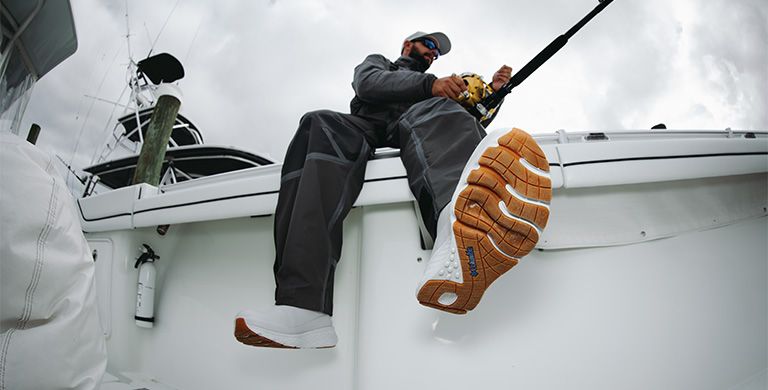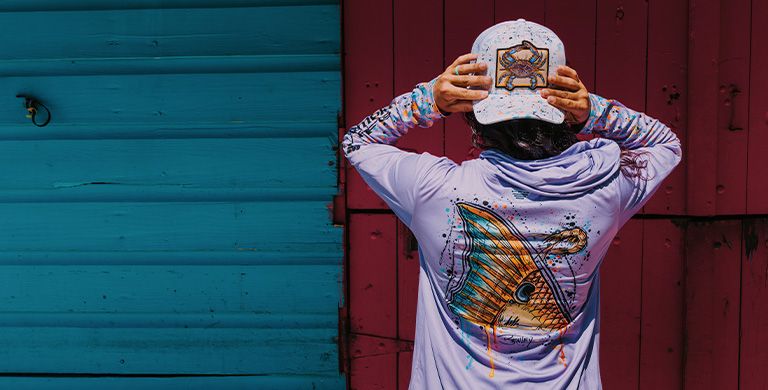
FISHING
Columbia’s Guide for What to Wear for Fresh and Salt Water Fishing
BY: NANCY BOUCHARD
Freshwater vs Saltwater Fishing Gear: One Thing’s Constant—You Wear What Works
There’s something special about fishing apparel—whether you’re gearing up for a freshwater fishing trip or heading offshore for saltwater fishing. It’s the magic cocktail of function meeting comfort and fashion. Whether you’re wading a freshwater creek with your fly rod or chasing offshore giants, what you wear says a lot—and does even more.
From sun protective fishing shirts to quick-dry saltwater fishing clothing, the right apparel isn’t just about looking the part. It helps you move better, fish longer, and stay protected from the elements. A famous angler once joked that when he looked good, the fish practically jumped in the boat. Confidence counts—and the right kit can boost both mindset and performance.
We talked with some of Columbia’s pro anglers to find out what fishing gear they rely on for both freshwater and saltwater. Their go-to picks show that having the right stuff isn’t just about comfort—it’s what turns a decent day on the water into a great one.
From sun protective fishing shirts to quick-dry saltwater fishing clothing, the right apparel isn’t just about looking the part. It helps you move better, fish longer, and stay protected from the elements. A famous angler once joked that when he looked good, the fish practically jumped in the boat. Confidence counts—and the right kit can boost both mindset and performance.
We talked with some of Columbia’s pro anglers to find out what fishing gear they rely on for both freshwater and saltwater. Their go-to picks show that having the right stuff isn’t just about comfort—it’s what turns a decent day on the water into a great one.

Freshwater Fishing Gear & Apparel: Built for the Conditions, Designed for the Day
For many anglers, the key to a smart freshwater fishing clothing system is versatility—and that starts with layering. Curtis Ciszek, an Oregon-based fishing guide always depends on layers. “If it’s going to be really cold, I bring a bunch of layers and shed them if I get too warm,” says Ciszek. “And always bring an extra layer in case you fall in.”
Ciszek says that while sun protection is the most important element of his freshwater fishing apparel, color is also key. He sticks with neutral tones that blend into the canyon walls of the Lower Deschutes River and builds his kit around the forecast.
Ciszek’s top gear picks shift with the seasons—from the PFG Mackenzie River jacket in late fall to the lightweight Uncharted Shirt in summer. As for Columbia’s tech, he’s not shy about what works. “For hot sunny days I must have a long sleeve shirt with a hood that has Omni-Wick and Omni-Shade built in,” he notes. “These PFG fishing shirts have sun protection that’s critical, especially during long hours on exposed water.”
Mark Daniels Jr., a pro on the Major League Fishing tour, takes a more mobile approach—but agrees with Ciszek that reading the weather forecast is essential. “Time of year and weather play a big role, but one of the first things I look for is weight,” he says. “I need to be very free and fluid on the boat—maneuverability is a big thing for me.” Even in colder months, Daniels prefers lightweight layers like down jackets that don’t slow him down. And when it heats up? “A light long sleeve hooded sun shirt is probably my favorite.”
His gear leans hard on simplicity and utility. “The hood knocks out the need for a buff or neck gaiter. It keeps me lighter,” he says. While he’s freshwater-first, Daniels doesn’t change much when fishing salt. “You might see me in sun protective pants or shorts in Florida, but I generally wear the exact same thing.”
Ciszek says that while sun protection is the most important element of his freshwater fishing apparel, color is also key. He sticks with neutral tones that blend into the canyon walls of the Lower Deschutes River and builds his kit around the forecast.
Ciszek’s top gear picks shift with the seasons—from the PFG Mackenzie River jacket in late fall to the lightweight Uncharted Shirt in summer. As for Columbia’s tech, he’s not shy about what works. “For hot sunny days I must have a long sleeve shirt with a hood that has Omni-Wick and Omni-Shade built in,” he notes. “These PFG fishing shirts have sun protection that’s critical, especially during long hours on exposed water.”
Mark Daniels Jr., a pro on the Major League Fishing tour, takes a more mobile approach—but agrees with Ciszek that reading the weather forecast is essential. “Time of year and weather play a big role, but one of the first things I look for is weight,” he says. “I need to be very free and fluid on the boat—maneuverability is a big thing for me.” Even in colder months, Daniels prefers lightweight layers like down jackets that don’t slow him down. And when it heats up? “A light long sleeve hooded sun shirt is probably my favorite.”
His gear leans hard on simplicity and utility. “The hood knocks out the need for a buff or neck gaiter. It keeps me lighter,” he says. While he’s freshwater-first, Daniels doesn’t change much when fishing salt. “You might see me in sun protective pants or shorts in Florida, but I generally wear the exact same thing.”

Saltwater Fishing Gear & Apparel: Built to Withstand the Elements—and the Attitude
If freshwater fishing gear is about adapting to the weather, saltwater fishing clothing is about standing up to the elements. Sun, salt, fish blood, thawed chum, rough seas—it’s a different beast, and it calls for gear that can take a beating and still perform.
According to long-time saltwater fishing pro and angling legend, George Poveromo, the essentials come down to protection and practicality. “I seek sun protection, a comfortable, semi-loose fit for ease when casting and fighting fish, and superior ventilation—with no heat retention,” he says. That focus on performance isn’t just about comfort—it’s essential in choosing the right saltwater fishing gear to face UV, spray, and fatigue. “Saltwater requires more protection from the sun and harsh marine elements, as well as specialized footwear,” Poveromo explains. “After all, we catch bigger fish.”
Poveromo lives in Columbia’s PFG Blood and Guts gear for good reason. “I find the wear to be quite comfortable, cool, and stylish in a traditional fashion,” he says. “Most blood and grime can be sprayed off with a washdown hose or wiped away with a soaked towel.” That’s not just a convenience—it’s a game changer when the day runs long and hunger sets in. “It enables us to grab a quick dinner after a late day on the boat without first having to go back to our hotel rooms and shower,” he says. “We may not be the freshest-smelling folks in the restaurant, but we’re presentable enough to always get seated.”
While he sticks to long sleeves and pants most of the time, he’ll switch it up in the heat. “Sometimes, when I’m not too lazy in the morning to apply sunscreen on my legs, I’ll wear shorts,” he laughs, favoring Columbia’s PFG Terminal Tackle II shorts for hot summer days.
Color also plays a tactical role. “I wear blue shirts quite often, believing they blend in with the sky to a fish looking upward,” Poveromo says. “White works too, but vivid and light blues are best. Green, yellow, and other vibrant colors are fine when trolling, live-baiting, or bottom fishing, where fish aren’t close enough to see anglers.”
His footwear choices—from fishing deck boots to running-style shoes—are just as dialed. On calmer days, it’s all about sneaker-style PFG fishing shoes with thick shock-absorbing soles. But when the weather kicks up, “the new PFG Pro Sport Deck Boots are ideal for those rough days when you just know you’ll be getting your feet wet, plus they have cushioning that absorbs the pounding from running in rough seas.”
For anyone building a saltwater kit from scratch, Poveromo has one word: protection. “Opt for long sleeves, long pants, hoodies for head protection and coolness,” he advises. “And don’t forget a wide-brim hat, polarized sunglasses, and sunscreen—apply it before you leave the house or hotel room.”
According to long-time saltwater fishing pro and angling legend, George Poveromo, the essentials come down to protection and practicality. “I seek sun protection, a comfortable, semi-loose fit for ease when casting and fighting fish, and superior ventilation—with no heat retention,” he says. That focus on performance isn’t just about comfort—it’s essential in choosing the right saltwater fishing gear to face UV, spray, and fatigue. “Saltwater requires more protection from the sun and harsh marine elements, as well as specialized footwear,” Poveromo explains. “After all, we catch bigger fish.”
Poveromo lives in Columbia’s PFG Blood and Guts gear for good reason. “I find the wear to be quite comfortable, cool, and stylish in a traditional fashion,” he says. “Most blood and grime can be sprayed off with a washdown hose or wiped away with a soaked towel.” That’s not just a convenience—it’s a game changer when the day runs long and hunger sets in. “It enables us to grab a quick dinner after a late day on the boat without first having to go back to our hotel rooms and shower,” he says. “We may not be the freshest-smelling folks in the restaurant, but we’re presentable enough to always get seated.”
While he sticks to long sleeves and pants most of the time, he’ll switch it up in the heat. “Sometimes, when I’m not too lazy in the morning to apply sunscreen on my legs, I’ll wear shorts,” he laughs, favoring Columbia’s PFG Terminal Tackle II shorts for hot summer days.
Color also plays a tactical role. “I wear blue shirts quite often, believing they blend in with the sky to a fish looking upward,” Poveromo says. “White works too, but vivid and light blues are best. Green, yellow, and other vibrant colors are fine when trolling, live-baiting, or bottom fishing, where fish aren’t close enough to see anglers.”
His footwear choices—from fishing deck boots to running-style shoes—are just as dialed. On calmer days, it’s all about sneaker-style PFG fishing shoes with thick shock-absorbing soles. But when the weather kicks up, “the new PFG Pro Sport Deck Boots are ideal for those rough days when you just know you’ll be getting your feet wet, plus they have cushioning that absorbs the pounding from running in rough seas.”
For anyone building a saltwater kit from scratch, Poveromo has one word: protection. “Opt for long sleeves, long pants, hoodies for head protection and coolness,” he advises. “And don’t forget a wide-brim hat, polarized sunglasses, and sunscreen—apply it before you leave the house or hotel room.”

Fishing Clothing for Both Worlds: Versatile Saltwater and Freshwater Apparel That Travels
Connor Allison, PFG Brand Manager at Columbia, sees a shift toward versatility in how anglers shop. “We listen to our athletes and consumers when it comes to designing saltwater and freshwater fishing gear,” he says, “We are specific with our designs and use of technology, but in general, there’s a lot of crossover. Anglers find what works best for themselves.”
Connor notes that the technologies—Omni-Wick, Omni-Shade, Blood and Guts and quick-dry fabrics—transfer seamlessly. “Fishing the Deschutes in June or the Keys in July? That same shirt works in both places.” But that doesn’t mean style is an afterthought. “More muted blues work better in Florida to blend in; in Oregon, anglers might prefer more earth tones. It really depends on where you are fishing.”
As gear becomes more adaptable, especially for a younger generation of anglers always on the move, Columbia’s Adventure Angler Collection leads the charge. “Lightweight, comfortable, versatile apparel that performs wherever you are,” is the perfect trifecta for anglers who mix it up or travel.
Connor notes that the technologies—Omni-Wick, Omni-Shade, Blood and Guts and quick-dry fabrics—transfer seamlessly. “Fishing the Deschutes in June or the Keys in July? That same shirt works in both places.” But that doesn’t mean style is an afterthought. “More muted blues work better in Florida to blend in; in Oregon, anglers might prefer more earth tones. It really depends on where you are fishing.”
As gear becomes more adaptable, especially for a younger generation of anglers always on the move, Columbia’s Adventure Angler Collection leads the charge. “Lightweight, comfortable, versatile apparel that performs wherever you are,” is the perfect trifecta for anglers who mix it up or travel.
Whether you’re chasing bass, bones, or browns, Columbia PFG fishing clothing and footwear is built for wherever your line takes you—freshwater or saltwater.



